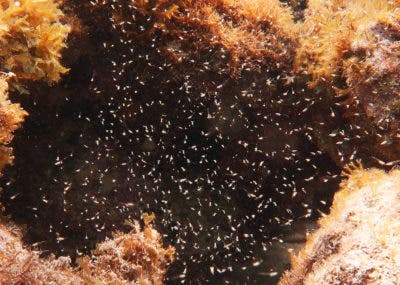
Domestication changed human history forever. Judging from mitochondrial DNA, scientists believe that the dog was the first animal to be domesticated nearly 14,000 years ago from wolves. Later, came farm domestications, including animals such as sheep, goats, pigs, and cattle. But humans aren’t alone in this game.
According to a fascinating new study by Australian researchers, longfin damselfish (Stegastes diencaeus) have domesticated mysid shrimp (Mysidium integrum), whose feces is a good fertilizer for the algae that the fish farms.
“Domesticator-domesticate relationships are specialized mutualisms where one species provides multigenerational support to another in exchange for a resource or service, and through which both partners gain an advantage over individuals outside the relationship. While this ecological innovation has profoundly reshaped the world’s landscapes and biodiversity, the ecological circumstances that facilitate domestication remain uncertain,” the authors wrote in their study published in Nature Communications.
“Mysids passively excrete nutrients onto farms, which is associated with enriched algal composition, and damselfish that host mysids exhibit better body condition compared to those without,” they added.
When researchers at Griffith and Deakin Universities first observed this behavior during dives to coral reefs in Belize, they almost couldn’t believe it. It wasn’t some fluke or misunderstanding either, as subsequent lab tests confirmed that damselfish were indeed in a domesticator-domesticate relationship with the shrimp.

The researchers found that the mysids are attracted to the odor of the damselfish, but are repelled by the smell of predators. The mysids also don’t seem to be attracted to non-farming fish nor the algae itself.
When the shrimp were around, the quality of the algae and the health of the fish improved. In return for the shrimp’s fertilization of their farm, the fish actively protect the mysids. The researchers found that outside the algae farms, other fish tried to eat the shrimp, but inside the farm under the watchful eyes of the damselfish, predators didn’t come close.
“This is not unlike the series of theoretical steps underpinning the domestication of animals by our own ancestors via the commensal pathway, where animals who were attracted to human settlements were subsequently domesticated by ancient humans,” Dr. William Feeney from Griffith University’s Environmental Futures Research Institute and co-author of the new study, said in a statement.
“It is generally food scraps or shelter that are thought to have attracted animals to humans.”
The domestication of other species was long considered to be uniquely human. While we know of ants that have domesticated fungi, finding examples of animal domestication by species other humans has proven elusive thus far. So, in many ways, seeing another species performing its own domestication may tell us much about how we first domesticated familiar species like cats, dogs, and chickens.
“This study highlights the important role that protection from predators also plays in domestication, with mysids shrimp quickly consumed by other predators when the damselfish farmer wasn’t present,” Feeney said.
“It reveals the fascinating insights into domestication by humans that can be gained by examining relationships between non-human organisms.”






